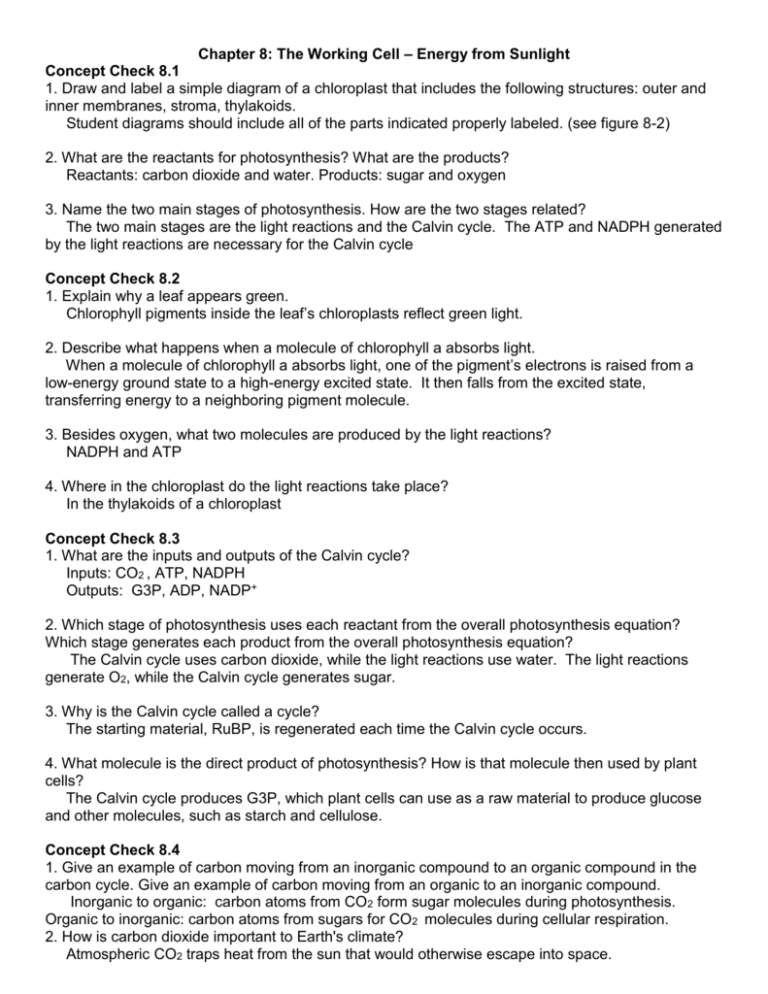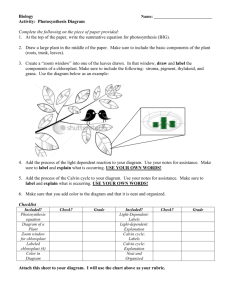Chapter 7: The Working Cell – Energy from Food
advertisement

Chapter 8: The Working Cell – Energy from Sunlight Concept Check 8.1 1. Draw and label a simple diagram of a chloroplast that includes the following structures: outer and inner membranes, stroma, thylakoids. Student diagrams should include all of the parts indicated properly labeled. (see figure 8-2) 2. What are the reactants for photosynthesis? What are the products? Reactants: carbon dioxide and water. Products: sugar and oxygen 3. Name the two main stages of photosynthesis. How are the two stages related? The two main stages are the light reactions and the Calvin cycle. The ATP and NADPH generated by the light reactions are necessary for the Calvin cycle Concept Check 8.2 1. Explain why a leaf appears green. Chlorophyll pigments inside the leaf’s chloroplasts reflect green light. 2. Describe what happens when a molecule of chlorophyll a absorbs light. When a molecule of chlorophyll a absorbs light, one of the pigment’s electrons is raised from a low-energy ground state to a high-energy excited state. It then falls from the excited state, transferring energy to a neighboring pigment molecule. 3. Besides oxygen, what two molecules are produced by the light reactions? NADPH and ATP 4. Where in the chloroplast do the light reactions take place? In the thylakoids of a chloroplast Concept Check 8.3 1. What are the inputs and outputs of the Calvin cycle? Inputs: CO2 , ATP, NADPH Outputs: G3P, ADP, NADP+ 2. Which stage of photosynthesis uses each reactant from the overall photosynthesis equation? Which stage generates each product from the overall photosynthesis equation? The Calvin cycle uses carbon dioxide, while the light reactions use water. The light reactions generate O2, while the Calvin cycle generates sugar. 3. Why is the Calvin cycle called a cycle? The starting material, RuBP, is regenerated each time the Calvin cycle occurs. 4. What molecule is the direct product of photosynthesis? How is that molecule then used by plant cells? The Calvin cycle produces G3P, which plant cells can use as a raw material to produce glucose and other molecules, such as starch and cellulose. Concept Check 8.4 1. Give an example of carbon moving from an inorganic compound to an organic compound in the carbon cycle. Give an example of carbon moving from an organic to an inorganic compound. Inorganic to organic: carbon atoms from CO2 form sugar molecules during photosynthesis. Organic to inorganic: carbon atoms from sugars for CO2 molecules during cellular respiration. 2. How is carbon dioxide important to Earth's climate? Atmospheric CO2 traps heat from the sun that would otherwise escape into space.











